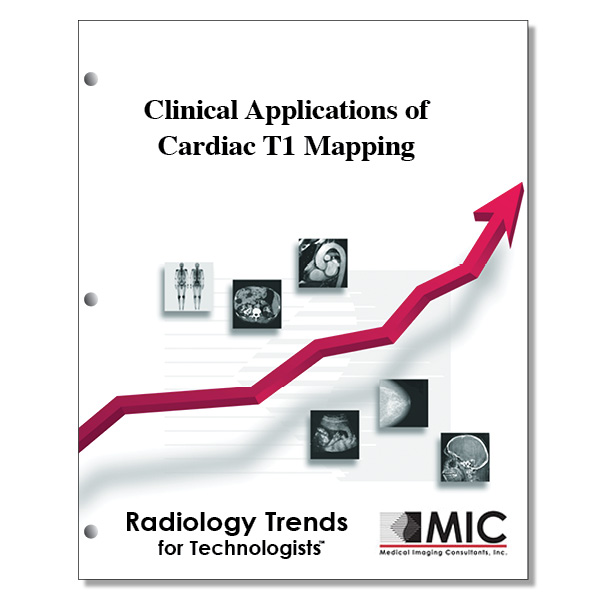

Clinical Applications of Cardiac T1 Mapping
Current and developing clinical applications of cardiac T1 mapping are presented and evidence of its diagnostic and prognostic value for various clinical conditions are reviewed.
Course ID: Q00494 Category: Radiology Trends for Technologists Modality: MRI2.5 |
Satisfaction Guarantee |
$29.00
- Targeted CE
- Outline
- Objectives
This course has been approved for 2.5 Category A credits.
No discipline-specific Targeted CE credit is currently offered by this course.
Outline
- Introduction
- Basic Concepts behind Cardiac T1 Mapping
- T1 Mapping versus T1-weighted MR Imaging
- Native T1 and ECV to Characterize Myocardial Structure
- Myocardial Composition
- Considerations for Normal T1 relaxation Times
- Implementation of Cardiac T1 Mapping in Routine Cardiac MR
- Applications Based on Native Myocardial T1
- Myocardial Edema
- Storage Disease
- Myocardial Fibrosis
- Post-Gadolinium Chelate Applications and ECV
- Replacement Fibrosis and Interstitial Fibrosis
- LGE versus ECV
- Valvular Disease
- Congenital Heart Disease
- Storage Disease
- Chemotherapy-induced Myocardial Injury
- Myocardial Inflammation
- Myocardial Fibrosis and Paradigms of Vulnerability to Adverse Outcomes
- Limitations of T1 Mapping
- Future Role of Cardiac T1 Mapping
- Conclusion
Objectives
Upon completion of this course, students will:
- list the indications for which cardiovascular MR has become the noninvasive modality of choice
- describe the calculation used by Friedrich et al. to determine the presence of acute myocarditis
- identify the MR pulse sequence introduced in 2004 that allowed for high-resolution cardiac T1 mapping in a single breath hold at clinical field strength
- identify the targets for native T1 and ECV measurements
- describe the percentage of normal human myocardial tissue volume occupied by the cardiomyocyte
- identify the most numerous cell in human myocardium
- describe the three-dimensional network around myocytes that provides structural support, transmits forces, and maintains tissue architecture
- identify the fibrillar collagen subtype that confers elasticity
- describe the most frequently used gadolinium-based contrast media in MR imaging
- list the compartments that comprise the myocardium
- describe the effect of myocardial edema on T1 and T2 values
- identify the condition that accompanies any acute myocardial injury
- identify the MR imaging technique that is best for identifying myocardial edema associated with acute myocarditis
- list the cardiac storage diseases that result in increased myocardial T1 values
- list the areas of the myocardium that demonstrate changes in native T1 values in the setting of Anderson-Fabry disease
- describe the time constant associated with local magnetic field alterations from ferric iron
- identify the MR imaging technique that demonstrates superior sensitivity and reproducibility for measuring myocardial iron levels
- list conditions associated with increased native cardiac T1 values
- describe the sequelae represented by myocardial replacement fibrosis
- identify the most common form of replacement fibrosis excluded by ECV measurement
- describe the most extensively validated technique for the detection and quantification of myocardial infarction
- describe the type of myocardial fibrosis that cannot be evaluated by cardiac MR imaging with LGE
- list the regions where T1 properties are measured in order to calculate ECV
- identify the value included in the calculation for ECV to correct for the displacement of gadolinium contrast material by erythrocytes
- describe the effects demonstrated by T1 mapping studies of patients with severe aortic stenosis
- identify the cardiac chamber where T1 mapping is affected by specific technical problems in patients with congenital heart diseases
- list the factors that determine the degree of myocardial damage resulting from anthracycline therapy
- list the inflammatory myocardial diseases that can result in increased gadolinium uptake on conventional MR imaging
- describe ECV as a prognostically powerful risk factor for adverse cardiovascular outcomes
- identify the cardiac chamber where partial volume effects limit the ability of T1 mapping to measure structures
- list the layers of the myocardium that should be avoided when obtaining T1/ECV data to reduce partial volume effects
- describe the percentage range for upper limits of normal ECV
- describe the time scale suggested to standardize native T1 data measured from different vendors
- identify disorders that can decrease native myocardial T1 values
- list the steps needed to integrate native T1 and ECV measurements in existing cardiac MR protocols
